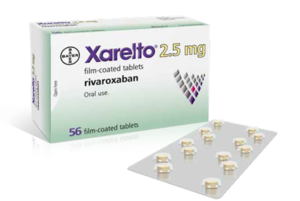 In a large, population-based study of patients with atrial fibrillation (AF) and valvular heart disease, those receiving apixaban had a lower risk for ischaemic stroke or systemic embolism and bleeding, and a lower rate of intracranial or gastrointestinal (GI) bleeding, when compared to those receiving rivaroxaban.
In a large, population-based study of patients with atrial fibrillation (AF) and valvular heart disease, those receiving apixaban had a lower risk for ischaemic stroke or systemic embolism and bleeding, and a lower rate of intracranial or gastrointestinal (GI) bleeding, when compared to those receiving rivaroxaban.
This was the conclusion put forward by Ghadeer K Dawwas (University of Pennsylvania, Philadelphia, USA) and colleagues in a paper published in the Annals of Internal Medicine. The findings should be considered by physicians when selecting anticoagulants in this patient population, the study’s authors have suggested.
“The lack of clinical trial evidence and wide use of both drugs in patients with AF and valvular heart disease calls for real-world evidence that can guide treatment selection in clinical practice,” said Dawwas, the first author of the study.
Using commercial data from Optum’s deidentified Clinformatics Data Mart Database, a US private insurance database, investigators analysed data from January 2013 to December 2020 with the aim of emulating a target trial of the effectiveness and safety of the two drugs in patients with AF and valvular heart disease.
A total of 9,947 patients who had recently started taking apixaban were compared with the same number of patients who were newly taking rivaroxaban. To adjust for potential baseline differences between the two groups, the study team calculated propensity scores using logistic regression, which was used to match patients in a 1:1 ratio. Researchers then calculated the incidence rates of the composite endpoint of ischaemic stroke or systemic embolism and the composite of intracranial and GI bleeding events as the total number of events per 1,000 person years.
Dawwas et al report that the incidence rate of ischaemic stroke or systemic embolism per 1,000 person-years of follow-up was 5.2 among apixaban users and 9.1 among rivaroxaban users. After matching, use of apixaban was associated with a lower rate of ischaemic stroke or systemic embolism (hazard ratio [HR] 0.57, 95% confidence interval [CI], 0.4–0.8).
Added to this, the incidence rate of GI or intracranial bleeding per 1,000 person-years of follow-up was 14.3 among apixaban users and 28.1 among rivaroxaban users. Use of apixaban was associated with a lower rate of GI or intracranial bleeding (HR 0.51,
CI 0.41–0.62). In total, 1,085 patients died, 587 in the apixaban group and 498 the rivaroxaban group. There was no statistically significant difference in all-cause mortality between apixaban and rivaroxaban users (HR 1.10, CI 0.97–1.24).
The analysis showed that the numbers of patients who had strokes or systemic emboli in each group diverged almost immediately. Patients in the rivaroxaban group had markedly more of these events at six months and 12 months of follow-up.
Overall, the results suggested that, in comparison to the rivaroxaban group, the apixaban group had 43% lower risk of stroke or systemic embolism, and 49% the risk of a bleeding events compared with rivaroxaban.
“Until evidence from randomised controlled trials becomes available, we believe clinicians should consider our findings when selecting anticoagulants in patients with AF and valvular heart disease,” said study senior author Sean Hennessy (University of Pennsylvania, Philadelphia, USA).










